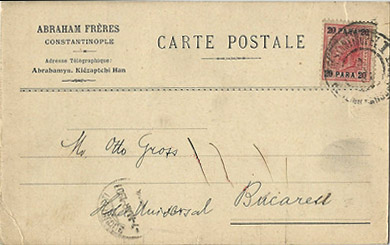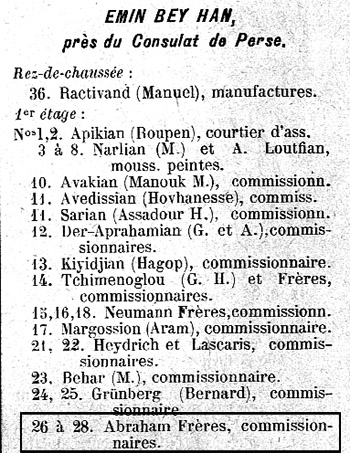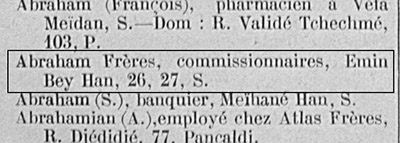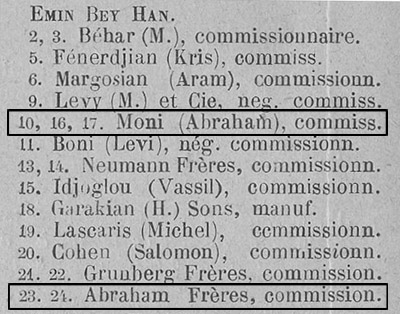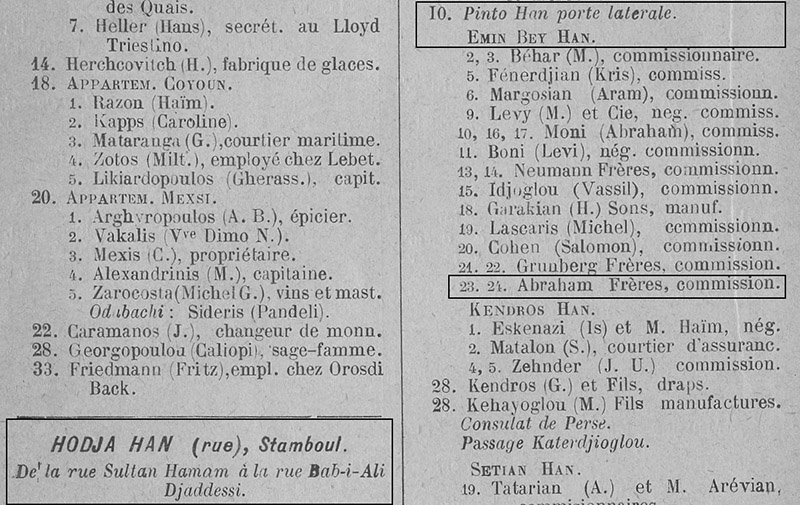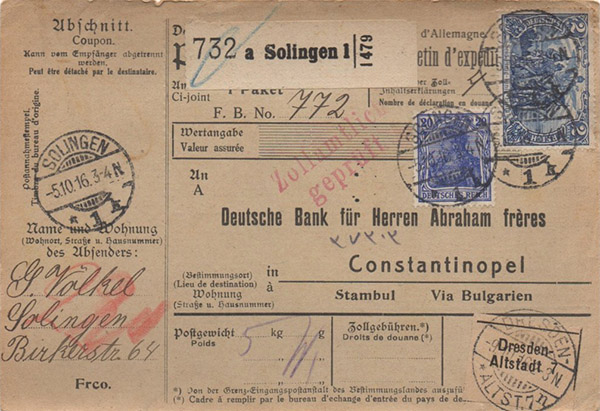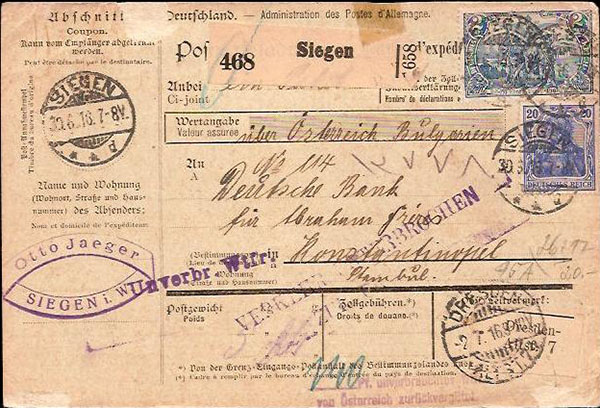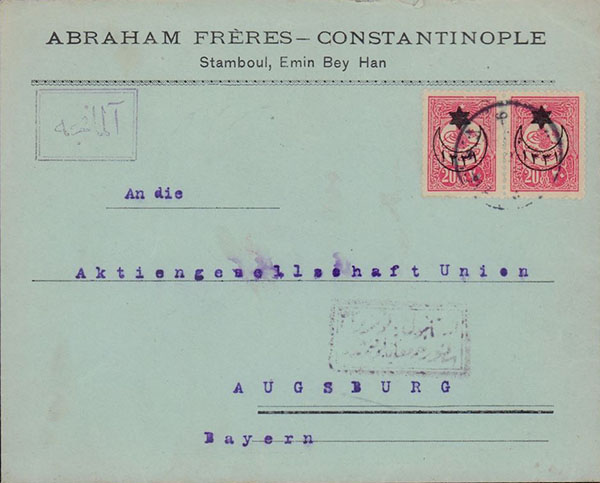Abraham Frères

Abraham Frères, letterhead, 1918.
In 1906, Moritz Abraham and Haim Abraham, two orphaned brothers from Rushtchuk in Bulgaria left their home and came to Constantinople, the capital of the Ottoman Empire. There, they established Abraham Frères, an importer of small manufactured goods from Germany and Central Europe. Their business was successful , and they were variously described as "prosperous merchants" and "well-to-do importers".
While their business required them to frequently travel, or to temporarily relocate to Germany or Vienna during the first World War, they also devoted much time to Zionist activism. They both belonged to Maccabi, the Jewish athlelic organization Maccabi, with Haim in particular being one of its leaders and the main driver for transforming the association into a national-Zionist group. Moritz and Haim both belonged Bnei Brit, another proto-Zionist group, which provided help to children's education, and provided fee food for victims of the Balkan wars; Finally, Moriz led the short-lived Zionist Federation of the Orient, an umbrella for 16 organizations with 6,000 members.
Their partnership would last until its dissolution in 1922, at which time they continued their business activities separately.
Haim had started his business career after returning from his studies in Kronsdatd in 1903, working first as an employee, then as a partner, of a Rustchuk merchant until January 29, 1906. Details about Moritz' early business experience are not known, but it can be assumed that he too had taken his first professional steps in Rustchuk.
It is not known whether the brothers had worked together in Rustchuk, or even whether they came to Constantinople together, although I assume they probably did. In 1906, Haim was 27 years old and Moritz 25.
The name of the company - Abraham Frères - was in French, as it was the lingua franca of the middle-class in Constantinople at the time. Interestingly, the name also appeared in Hebrew on their business card: "HaAchim Avraham, Koushta": "Avraham Brothers, Constantinople". The language used for business transactions however was most likely German, which the brothers had learned in school and spoke, presumably fluently. Haim, and most likely Moritz, had studied in Kronstadt and were both Germanophiles: back home in Ruschuk, Haim called himself Heinrich, while his brother - my grandfather - born Moshe - went by Moritz.

Abraham Frères - Constantinople, 1916. Labelled Envelope.
(Scan courtesy of Mehmet Sadettin Fidan)
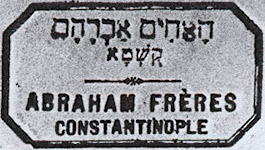
Abraham Frères stamp, 1916.
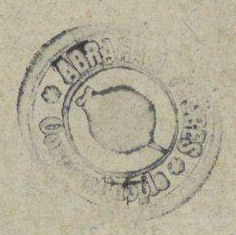
Abraham Frères stamp, October 1916.
(Source: ebay)

Abraham Frères stamp, January 1917.
(Source: ebay)
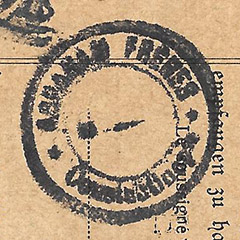
Abraham Frères stamp, January 1917.
Annuaire Oriental
The earliest mention of "Abraham Frères" appears the 1908 edition of the Annuaire Oriental, the trade registry of the Ottoman Empire. Printed on January 6, 1908, this suggests that the company existed since at least 1907. (The 1907 edition of the directory is not available online; The company may have been created as early as 1906 when the Abraham brothers first came to Constantinople.)
At first, the Abraham brothers ran their business from the Kezabdjioglou Han in the Stamboul neighborhood, where they occupied two room, #9 and #10. ("Han", originally meaning urban caravanserai, was the term used for multi-tenant building.) The han housed a mix of businesses, including hardware stores, enamel iron utensils, and hosiery, and only four commission agents.
Confirming that the partnership was already in existence in 1907 is this artifact bearing the name Abraham Frères.
Addressed to a Mr. Otto Gross (or Grosz) in Bucharest, this postcard shows that Abraham Frères was already operating in March 1907. The brothers used stationary with a simple address - Abraham Frères, Constantinople - and a similarly straightforward telegraphic address: "Abrahamym" ("Abrahams" in Hebrew). The name of the Han is barely legible ("Klezaplebi"?).
The company's name appears later that year in a list of donors to the Jewish National Fund published in the September 1908 issue of Die Welt. Abraham Frères were one of only three donors from Constantinople.
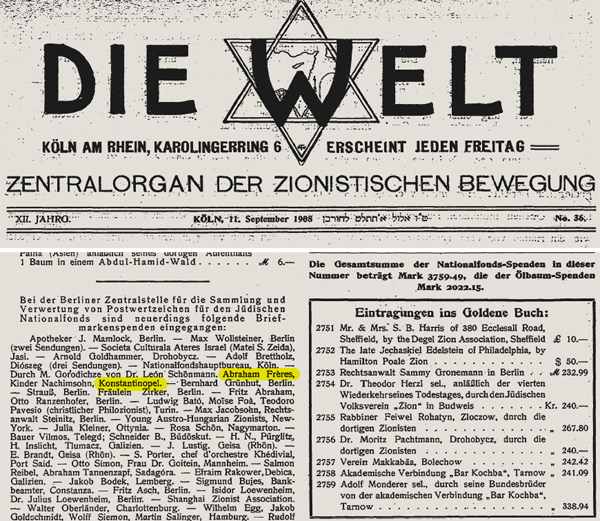
Abraham Frères listed in "Die Welt", September 1908.
The following year, the company's offices had moved to Emin Bey Han. Located on "Kocapaşahan Sokak" (Kodjapasha Han Street) in the "Sultanhamam" district, on the south side of the Golden Horn in Eminönü, near the Persian consulate and behind the post office of Sirkeci; this street name does not exist anymore. They now occupied three rooms, number 26 to 28, on the second floor of the building.
Almost all the tenants in the Emin Bey Han were "Commissionnaires".
According to the 1912 Annuaire Oriental, Abraham Frères later downsized and now occupied only two rooms, numbers 26 and 27.
The next year, in 1913, they moved again, this time to rooms 23 and 24.
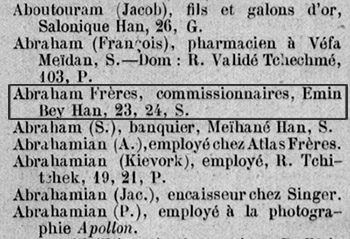
Abraham Frères in 1913 Annuaire Oriental.
A listing in the September 1920 issue of La Rassegna Italiana, the Official Journal of the Italian Chamber of Commerce in Constantinople, provides the most detailed description of their business found so far.
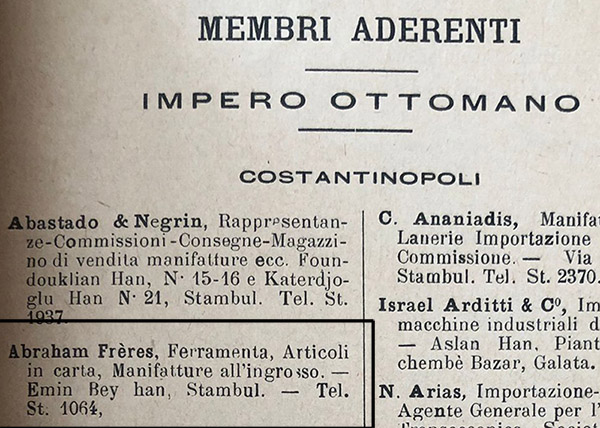
Abraham Frères in the Official Journal of the Italian Chamber of Commerce in Constantinople, September 1920.
Courtesy of Cenker Sarıkaya
Abraham Frères
Hardware, Paper Goods, Wholesale Manufactures.
Emin Bey han, Istanbul.
Tel. St. 1064
"Hardware" most likely encompassed all products sold in hardware stores. "Paper goods" presumably included stationary products beyond just paper products. The addition of the more generic "wholesale manufacture" suggests that they were not limiting themselves to these two categories, but were willing to trade in other types of manufactured products.
The 1921 Annuaire Oriental shows that they were still in the same location towards the end of their partnership:
The 1921 edition of the Annuaire Oriental includes details about the exact location of Emin Bey Han: it was on Hodja Han street, between Sultan Hamam and Bab-i-Ali Djaddessi streets.
All tenants except for one were commissionnaires, the majority Jewish, with a three Armenians, and two Greeks.
Abraham Frères were also listed in the "Import/Export" section of the 1920-1921 edition of the "Guide pratique et indicateur des voies et communications de Constantinople et banlieue":
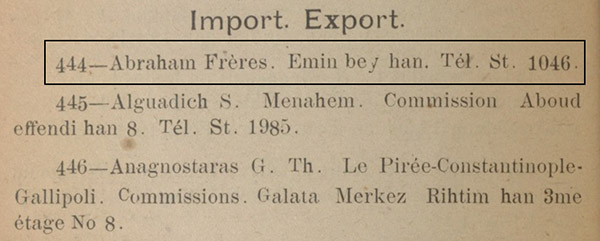
Guide pratique et indicateur des voies et communications de Constantinople et banlieue - 1920-1921
Address
Although some of the professional correspondance for Abraham Frères specified "Emin Bey Han" in the mailing address, most of it was simply addressed to "Abraham Frères, Constantinople", or "Herrn Abraham Frères, Konstantinopel - Stambul, Turkei".
There are also a few examples of personal correspondance addressed "c/o Abraham Frères", with no street or building information. For example, Haim sent this postcard from Vienna in 1913 to his sister-in-law Ronya, and simply addressed it to:
"Riwka Abraham,
c/o Abraham Frères,
Constantinople".
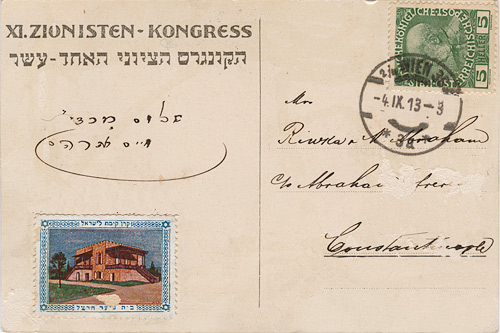
Postcard from Vienna - Sept 4, 1913.
Two more postcards, again from Haim Abraham to Ronya, addressed to "Rivka M. Abraham, c/o Abraham Frères, Constantinople". Although mailed from Palestine under Ottoman rule, these were sent through the Austrian post.
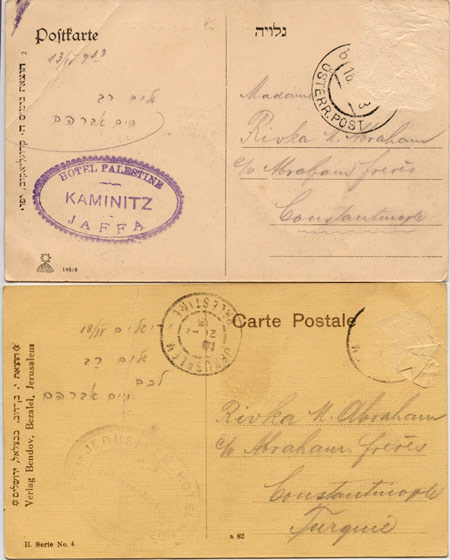
Two postcards from Haim Abraham to Ronya Datnowsky, 1913.
Products
About the business, all I was ever told was that Abraham Frères imported "cheap metal goods such as razor blades" from Germany and other central European countries, and distributed them "all over the Levant". This seems to have only been something my father had heard, and not something he knew first-hand, as he was only four years old by the time the partnership was dissolved in 1922.
Aside from the Annuaire Oriental, the primary source of information about the Abraham Frères's business comes from parcel cards that were used for two years during the First World War, presumably while regular shipping routes were disrupted. These cards often include the names of the exporting companies and a description of the products being shipped.
These cards reveal that Abraham Frères imported a fairly wide range of small consumer goods manufactured in Germany and in neighboring countries, including iron locks, shoe polish, ink, crafstmen tools and paper envelopes.
Below are some of the companies whose products they distributed.
- Carl Blanke, Wuppertal, Germany (Envelope Manufacturer)
- Hartmann & Mittler, Wien, Austria. (Sealing wax, bottle wax, and ink factory)
- Herczeg Geza, Chemische Fabrik, Budapest, Hungary. (Shoe polish, chemical factory)
- C. F. Schröder (Schroeder), Volmarstein, Germany. (Metal goods, including iron padlocks). (2 package cards).
- F.H. Schmidt, Torgau, Germany. (Envelopes) (*)
- Gebrüder Heuschen, (Heuschen Brothers), Elberfeld, Germany. (Rivets)
- Germania-Werk, Solingen, Germany. (Razor maker)
- Halbach & Böckmann, Barmen, Germany. (Small metal goods, including snap fasteners, shoe eyelets, hollow rivets, suspender buttons, cardboard clips and picture eyelets). (2 package cards).
- Herm. Ibach & Co., Elberfeld, Germany. (Unknown product)
- Kamphausen & Plümacher, Solingen-Ohligs, Germany. (Cutler/open-blade razor maker)
- Max Plümacher, Metallwaren-Fabrik, Weyer, Germany. (Metalgoods factory)
- Otto Jaeger, Siegen, Westphalia, Germany. (5 package cards, unknown products.)
- Paul Arzberger, Chemnitz, Germany. (Woven and knitted fabrics, scouring cloths, wicks, cords, gold and embroidery threads.)
- Paulmann & Kellermann, Elberfeld, Germany. (Envelopes) (3 package cards)
- Peter xxxxx & Söhne, Ohligs, Germany
- Picard-Werk GmbH, Cronenberg, Germany. (Hammers and craftsmen tools manufacturer) (3 package cards) (*)
- Völkel, Solingen, Germany. (Thread cutting tools) (three package cards) (*)
- William Prym, Stolberg (Rhineland), Germany. (Metal products: metal haberdashery, needles, zippers)
- Unknown, Wien, Austria. (Iron padlocks). Shipped by Mittler & Co
- Unknown, Vienna, shipped by Friedrich Samuely, freight forwarding company. (3 packet cards)
- Unknown, Hagen, Westphalia, Germany, shipped by H Münzing Spedition.
- Unknown, Hagen L. W., Germany, shipped by Lersch & Kruse. (3 packet cards)
Data courtesy of Mehmet Sadettin Fidan. *: Additional data from the author's collection.
Parcel receipt cards addressed to Abraham Frères
Below are parcel cards addressed to Abraham Frères between 1916 and 1917. These packet cards helps better understand Abraham Frères' business, as the cards often detail the types of products they imported. Because parcel cards have only been found for the years 1916/1917, it is assumed that shipping merchandise via postal packages to Constantinople from Germany and neighboring countries (Austria, Hungaria) was a short-term solution that allowed the business to continue to operate during the war years. I assume that before and after WW1, merchandises were shipped through more efficient transit routes. For this reason, these parcel cards only provide a glimpse of the business during the worst of the war years. They are however the only sources of information that remain, and as such are invaluable to help understand Abraham Frères' business.
Almost all parcel cards, except for one, list the weight of the package as 5kg (11 pounds), suggesting that this was the maximum weight that could be sent by parcel post. Multiple cards for shipments from the same company at the same date have surfaced, demonstrating that orders were broken down into multiple 5kg packages. The products ranged from iron padlocks to envelopes, ink and rivets, and it's not clear how many packets a single order could contain.
The disruptions caused by the war meant that a package could take several months to reach its destination. A thread on philaforum.com describes the path one package addressed to Abraham Frères followed in 1916. Sent at the end of June 1916 from Germany, it took three months and three weeks to reach Constantinople:
"A package from Otto Jaeger in Siegen, Westphalia was sent to Abraham Frères in Constantinople (Stambul) on June 30th, 1916. The shipment arrived on July 2nd, 1916 in Dresden. Then, a stamp 'traffic interrupted' was added. [...] The interruption of the mail traffic may have had to do with the Brusilov offensive (June to September 1916). [...] Probably not a direct interruption of the rail link to Turkey, rather, it must have been caused by the overloading of the railroad capacity."
"On September 3rd, 1916 the parcel is back (?) In Dresden (stamp on the reverse side). The parcel card then arrived in Stambul on October 19, 1916."
Völkel, Solingen. October 1916
Two packages from Völkel, from Solingen, Germany. Both cards were sent on October 5, 1916, suggesting that shipments were broken down into multiple packages of 5kg each.
Product is not listed.
Solingen was renowned for the manufacturing of knives, scissors and razors, so these packages may have been for one such product, possibly razor blades, which was one product Abraham Frères were known to have imported.
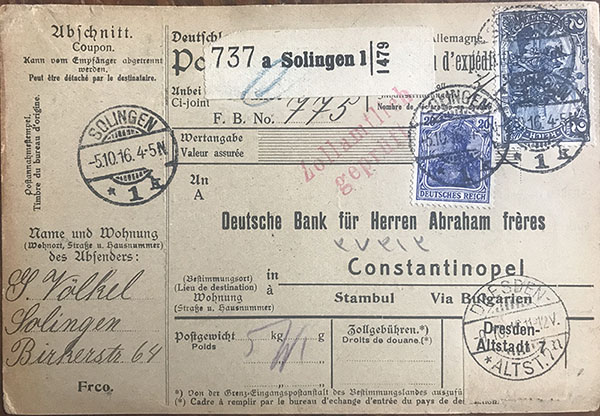
Parcel Card from Völkel. October 5, 1916.
(Collection of the author)
Germania-Werk
Packet card from Germania-Werk, Solingen, Germany, a manufacturer of razors.
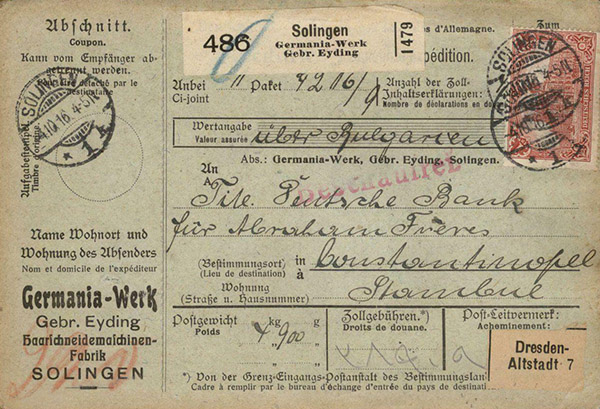
Packet card from Germania-Werk. October 1916.
(Source: ebay)
Kamphausen & Plümacher
Packet card from Kamphausen & Plümacher, Solingen-Ohligs, Germany, a manufacturer of cutlery and open-blade razors.
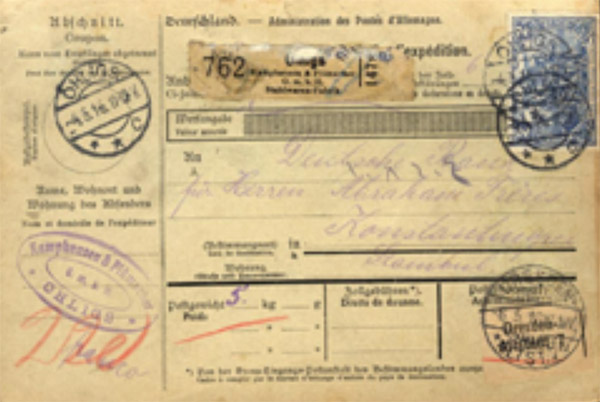
Parcel Card from Kamphausen & Plümacher. May or June 1916.
(Scan courtesy of Mehmet Sadettin Fidan)
Unknown, from Ohligs, Solingen.
Packet card from unknown company from Ohligs/Solingen, Germany.
Solingen was know as the "City of Blades", renowned for the manufacturing of knives, scissors and razors.
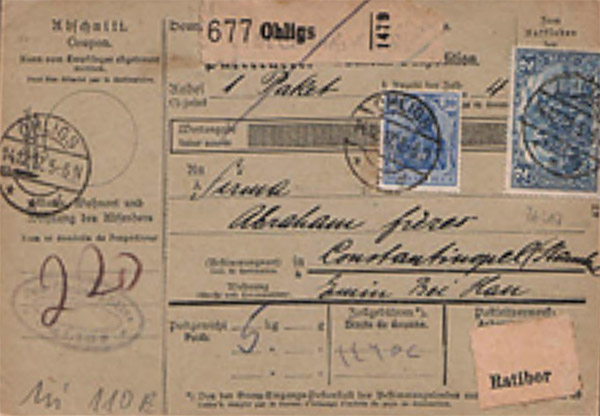
Parcel Card from unknown company in Solingen.
(Scan courtesy of Mehmet Sadettin Fidan)
C.F. Schroeder
Two packages from C.F. Schroeder, a manufacturer of metal goods located in Volmarstein and Hückeswagen, Germany. They manufactered padlocks, among other metal products.
According to the great-granddaughter of C.G. Schroeder: "C.F. Schroeder was known for his padlock factories." (December 2020).
These cards come from two separate orders, in June and October 1916.
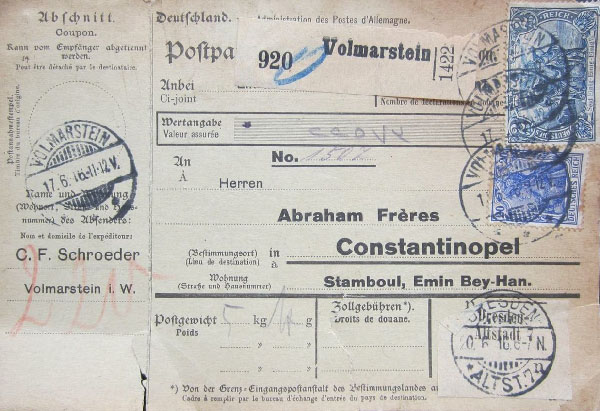
Parcel Card from C.F. Schroeder, Volmarstein. June 1916.
(Source: ebay)
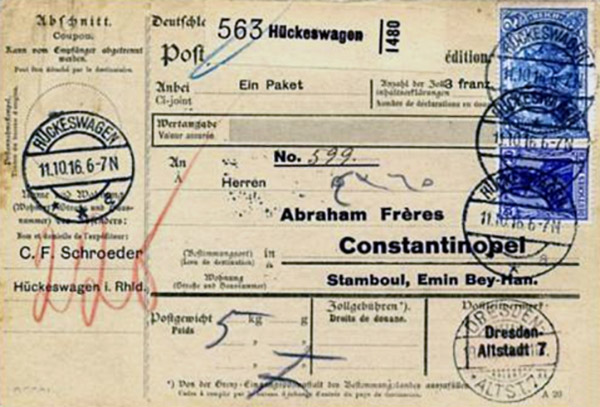
Parcel Card from C.F. Schroeder, Hückeswagen, Germany. October 1916.
(Scan courtesy of Mehmet Sadettin Fidan)
Unknown Company, Hungary
Iron padlocks from Szombathely, Hungary, shipped by Richard Mittler.
Unknown company.
Sent on September 25, 1917, these arrived in Constantinople two months later on November 27 and were apparently cleared on December 1.
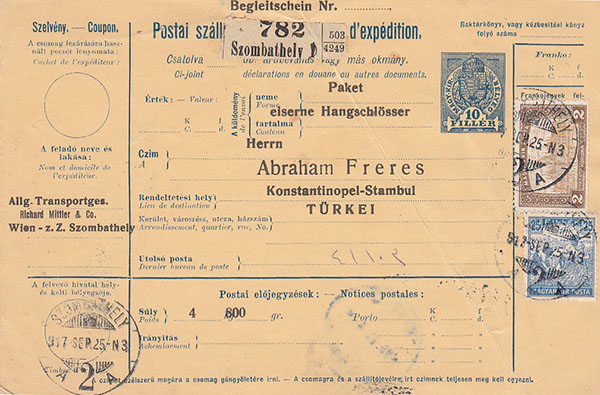
Parcel Card for iron padlocks from Hungary, shipped by Richard Mittler transport.
(Scan courtesy of Mehmet Sadettin Fidan)
Halbach & Böckmann
Halbach & Böckmann, Barmen, Germany, a manufacturer of small metal goods, including snap fasteners, shoe eyelets, hollow rivets, suspender buttons, cardboard clips and picture eyelets.
The "Celluloid" stickers however suggest the contents of the package may have contained the flamable material.
The cards seem to have been sent on two consecutive days - February 2 and February 3 1916.
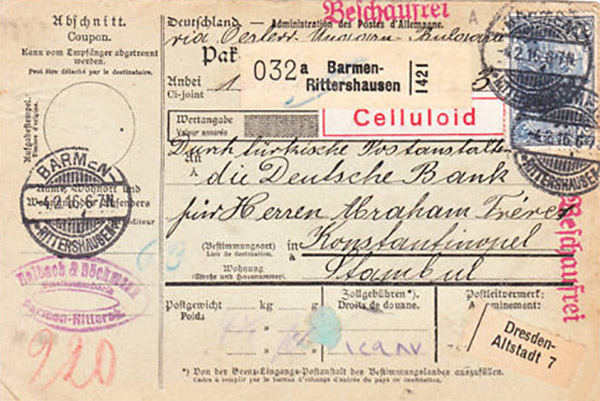
Parcel Card from Halbach & Böckmann, Barmen, Germany. February 1916.
(Scan courtesy of Mehmet Sadettin Fidan)

Parcel Card from Halbach & Böckmann, Barmen, Germany. February 1916.
(Scan courtesy of Mehmet Sadettin Fidan)
Gebrüder Heuschen
Package from Gebrüder Heuschen (Heuschen Brothers), from Elberfeld, Germany, a manufacturer of rivets.
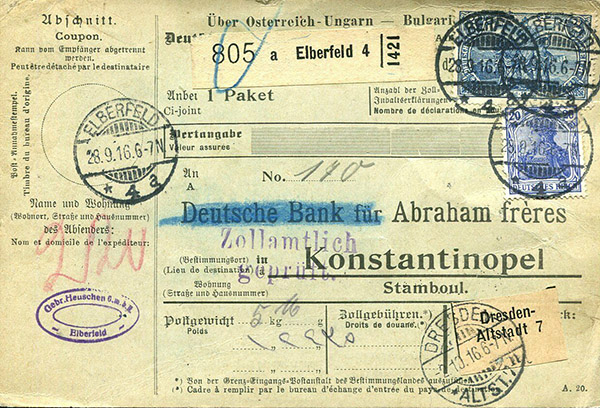
Parcel Card from Gebrüder Heuschen, Elberfeld, Germany. September 28, 1916.
(Collection of the author)
William Prym
Packet card from William Prym, Stolberg, Germany. Manufacturer of small metal products: metal haberdashery, needles, zippers.
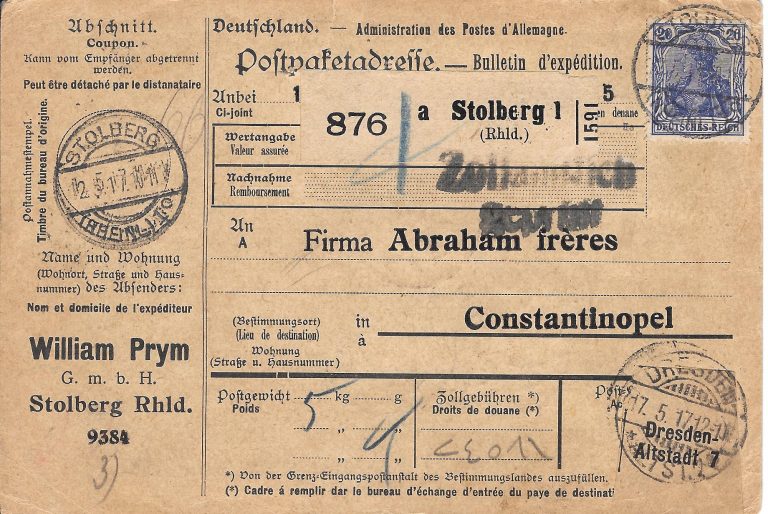
Parcel Card from William Prym from Stolberg, Germany. May 1917.
(Scan courtesy of Norbert Luffy)
Picard-Werk
Three package cards from Picard-Werk, a hammers and craftsmen tools manufacturer from Cronenberg, Rhineland-Palatinate, Germany.
These were sent on three different dates: November 10, November 12, and December 4, 1916.
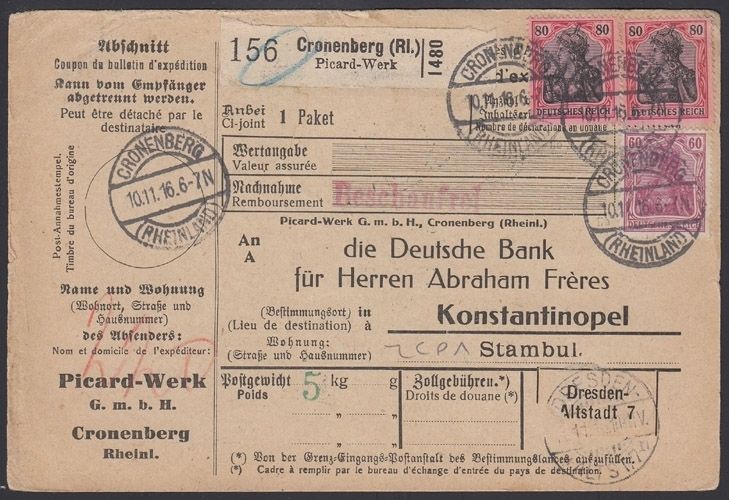
Parcel Card from Picard-Werk. November 10, 1916.
(Collection of the author)
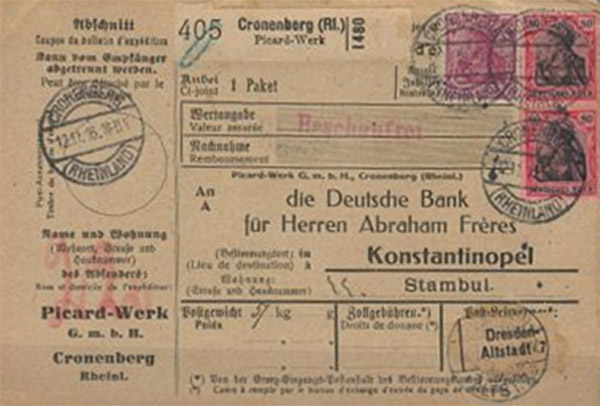
Parcel Card from Picard-Werk. November 12, 1916.
(Scan courtesy of Mehmet Sadettin Fidan)
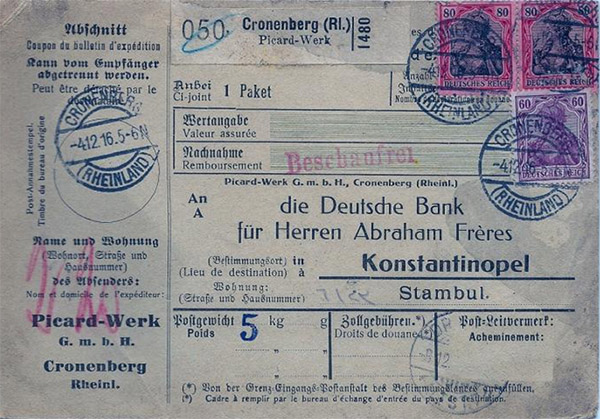
Parcel Card from Picard-Werk. December 1916.
(Scan courtesy of Mehmet Sadettin Fidan)
Paulmann & Kellermann
Three package cards from Paulmann & Kellermann, a paper envelope company from Elberfeld, Germany.
The first card was sent in November 1916. The other two were sent on December 5, 1916.

Parcel Card, Paulmann & Kellermann. November 1916.
(Scan courtesy of Mehmet Sadettin Fidan)

Parcel Card, Paulmann & Kellermann. December 5, 1917.
(Scan courtesy of Mehmet Sadettin Fidan)
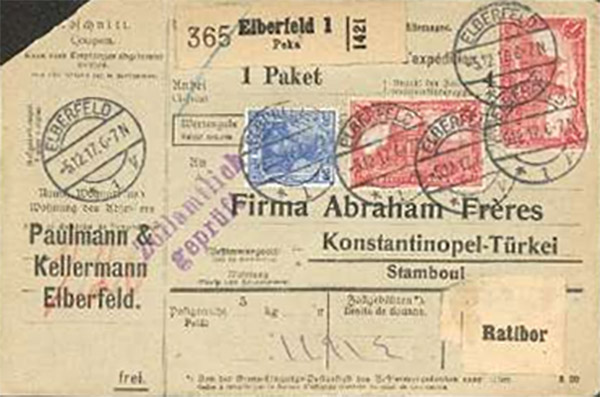
Parcel Card, Paulmann & Kellermann. December 5, 1916.
(Scan courtesy of Mehmet Sadettin Fidan)
F.H. Schmidt
F.H. Schmidt, an envelope factory from Torgau, Germany.
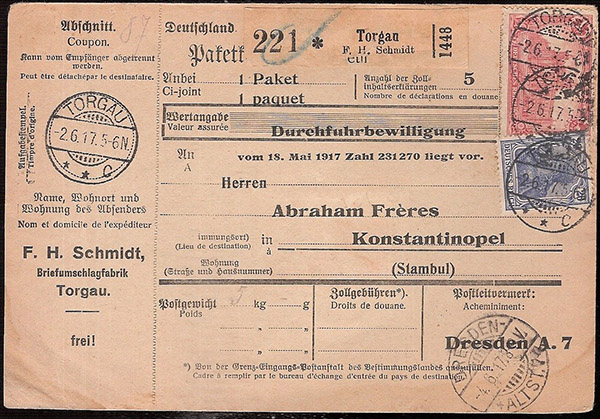
Parcel Card from the F.H. Schmidt. Torgau, Germany, June 1917.
(Collection of the author)
Carl Blanke
Carl Blanke, an envelope manufacturer from Wuppertal / Barmen, Germany.
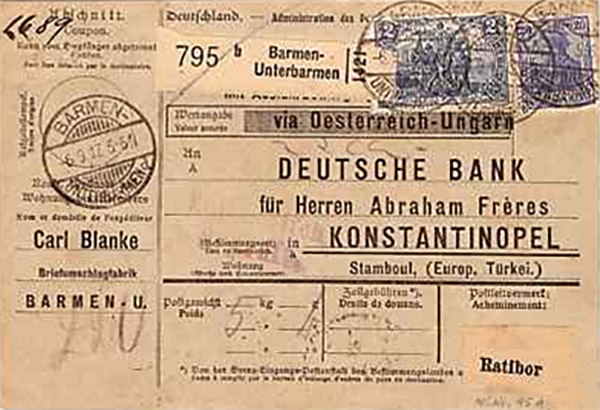
Parcel Card from the Carl Blanke envelope manufacture. September 1917.
(Scan courtesy of Mehmet Sadettin Fidan)
Hartmann Mittler
Hartmann Mittler, a sealing wax, bottle wax, and ink factory from Vienna.
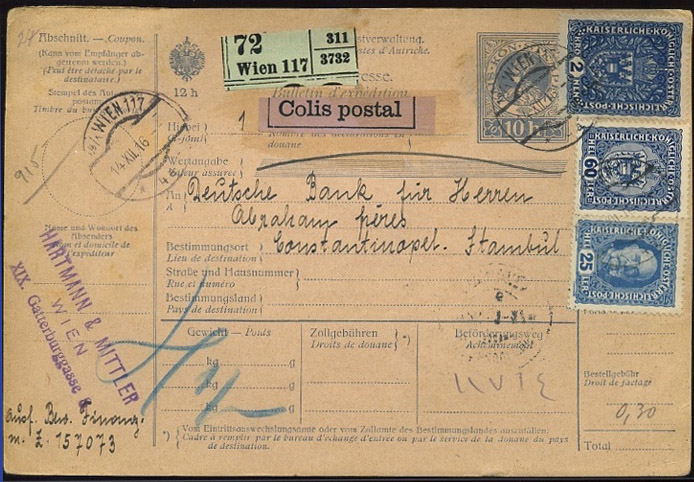
Parcel Card from Hartmann Mittler, a sealing wax, bottle wax, and ink factory from Vienna. December 1916.
(Scan courtesy of Ron Laby)
Herczeg Geza
Package card for shoe polish from Herczeg Geza, a chemical factory from Budapest, Hungary.
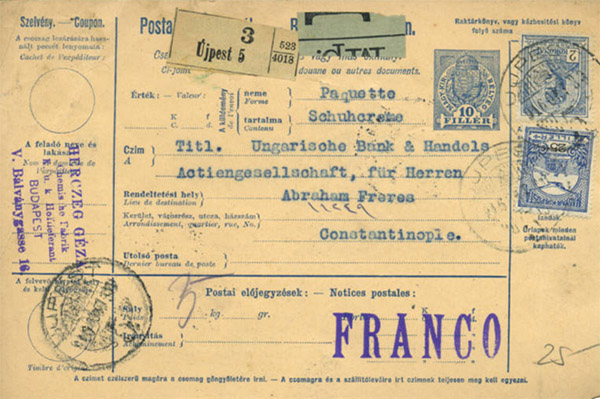
Parcel Card for shoe polish from Herczeg Geza, Budapest, Hungary.
(Scan courtesy of Mehmet Sadettin Fidan)
Herm. Ibach & Co.
One package from Hermann (?) Ibach & Co, Elberfeld, Germany.
Product line unknown.
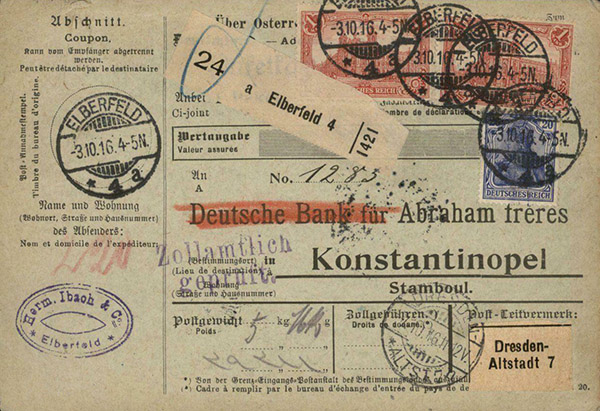
Parcel Card from Herm. Ibach & Co, Elberfeld, October 1916.
(Source: ebay)
Otto Jaeger
Five packet cards from Otto Jaeger, Siegen, Wesphalia, Germany.
Product line unknown.
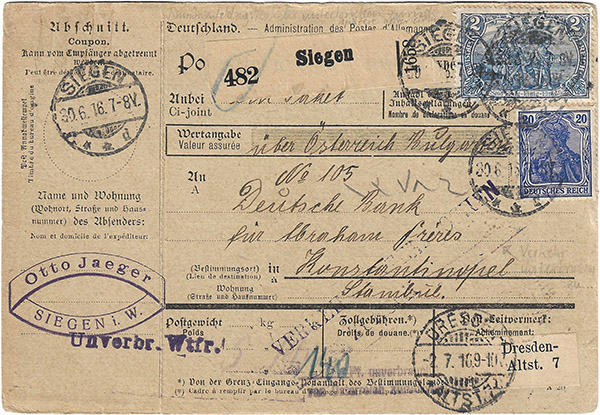
Parcel Card from Otto Jaeger, 30 June 1916.
Collection of the author
These two cards were part of a shipment that was sent on 30 June 1916 from Siegen in Germany. The shipment arrived on 2 July in Dresden. A stamp 'traffic interrupted' was added, suggesting a disruption to the train line cause by the war. On 2 September, the parcel was back - or maybe still - In Dresden. The shipment finally arrived in Constantinople on 19 October 1916, completing a journey that had taken three months and tree weeks.
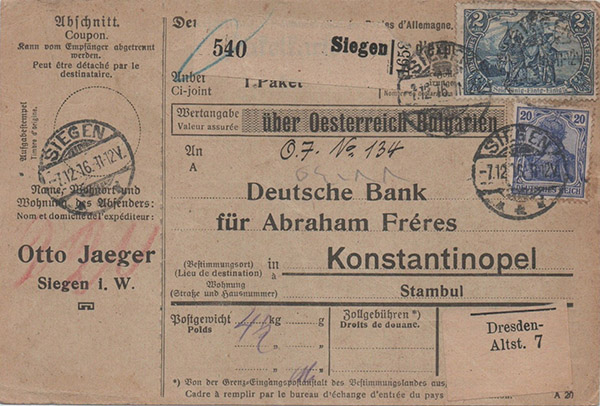
Parcel Card from Otto Jaeger, December 1916.
(Source: ebay)
Sent on December 7, 1916 from Siegen, the package arrived in Constantinople two months later on February 14, 1917.
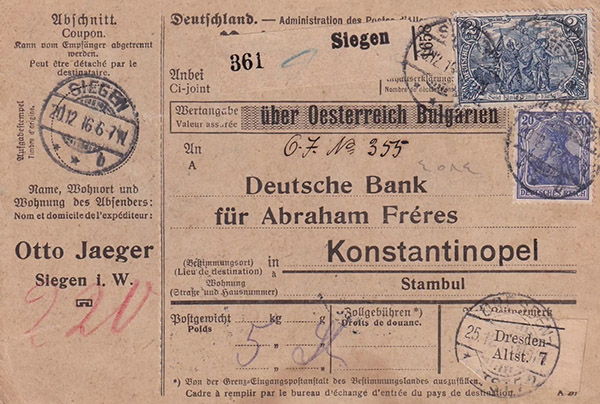
Parcel Card from Otto Jaeger, December 1916.
(Source: ebay)
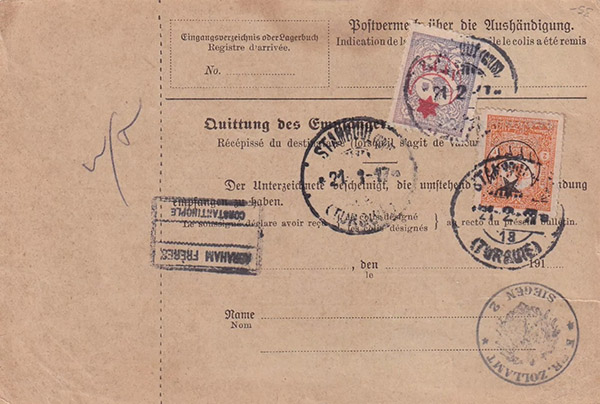
Parcel Card from Otto Jaeger, December 1916. (back)
(Source: ebay)
Sent on December 20, 1916 from Siegen, the package arrived in Constantinople one month later on January 21, 1917. The back of the receipt card includes Turkish tax stamps, and the Abraham Frères stamp.
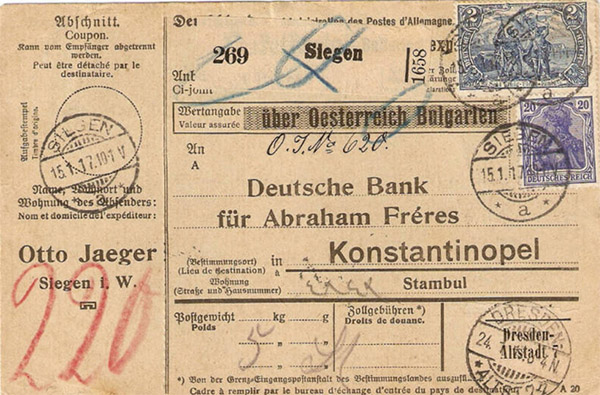
Parcel Card from Otto Jaeger, January 1917.
(Scan courtesy of Mehmet Sadettin Fidan)
Unknown Company, Hagen, July 1917
Three other cards mailed from Hagen, these through the transporter H. Münzing in July 1917.
No indication on the company or product shipped.
There are cryptic stamps: "Volma" and "Lud", which may be the name of the manufacturer or client.
H. Münzing was a transport business which provided "direct and prompt wagonload traffic to southern Germany and Switzerland".
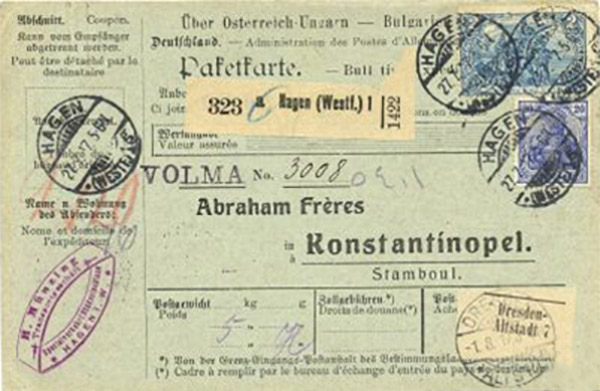
Parcel Card shipped by H. Münzing, Hagen. July 27, 1917.
(Scan courtesy of Mehmet Sadettin Fidan)
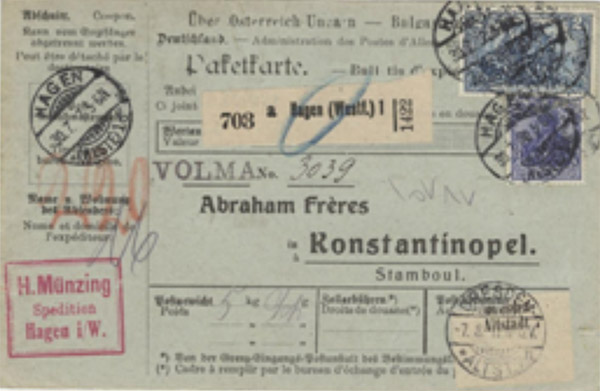
Parcel Card, shipped by H. Münzing, Hagen. July 30, 1917.
(Scan courtesy of Mehmet Sadettin Fidan)
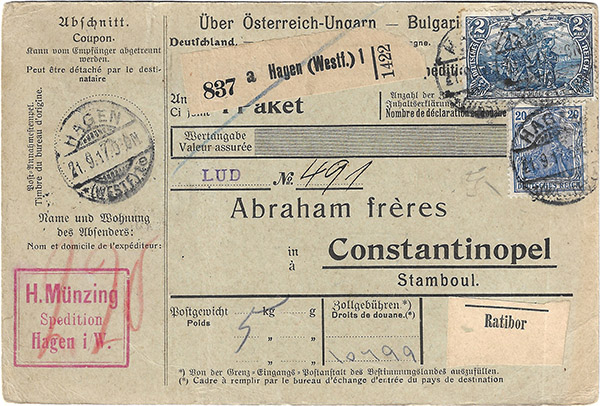
Parcel Card shipped by H. Münzing, Hagen. 21 September 1917.
(Collection of the author)
Unknown Company, Vienna, August 1917.
Three parcel cards from unknown company, shipped by Friedrich Samuely, Vienna. August-September 1917.
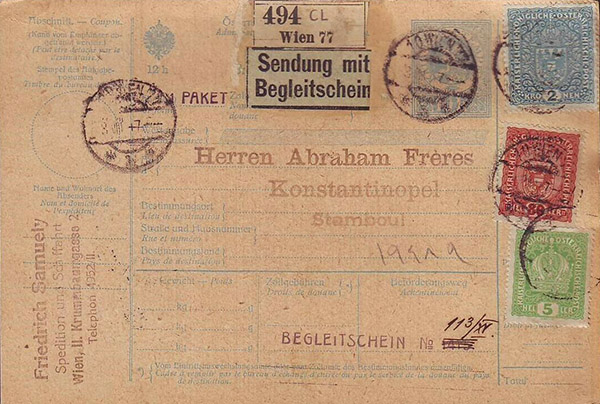
Unknown company. Shipped by Friedrich Samuely, Vienna. Arrived in Constantinople in September 1917.
(Collection of the author)
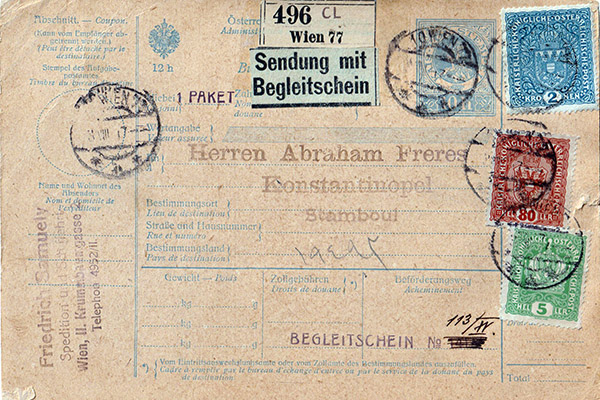
Unknown company. Shipped by Friedrich Samuely, Vienna. Sent around August 8, 1917. Arrived in Constantinople September 15, 1917.
(Collection of the author)
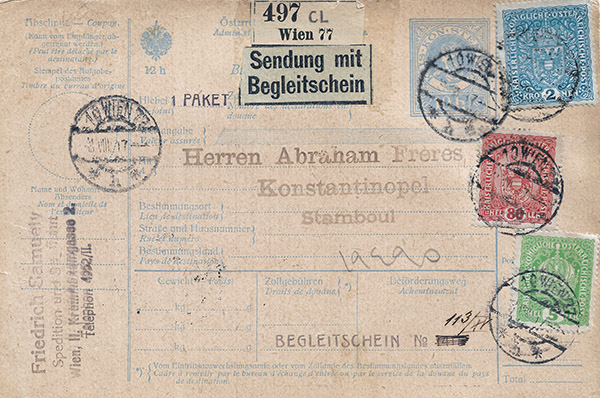
Unknown company. Shipped by Friedrich Samuely, Vienna. Sent around August 8, 1917. Arrived in Constantinople September 15, 1917.
(Collection of the author)
Unknown Company, Hagen, October 1917
Three cards mailed in October 1917 from Hagen, where Haim Abraham was residing at the time. The only information on the cards is for the transporter (Lersch & Kruse). There is unfortunately no indication of who the manufacturer was or what the shippement contained.
The cards have somewhat cryptic stamps: "Schalom" ("Peace") and "Ivri" ("Hebrew"). These may have been the names of the manufacturers, vendors or the customers, although I haven't found anyone named Ivri or Schalom in the 1913 Annuaire Oriental in Constantinople.
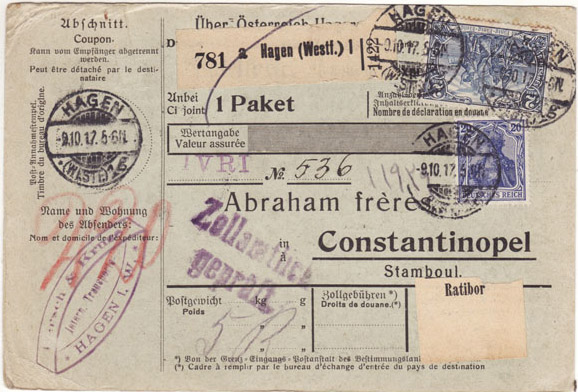
Parcel Card sent from Hagen, Germany, by Lersch & Kruse (transporter), October 9, 1917.
Card mailed from Hagen with "Ivri" ("Hebrew") stamp.
(Scan courtesy of Ron Laby)
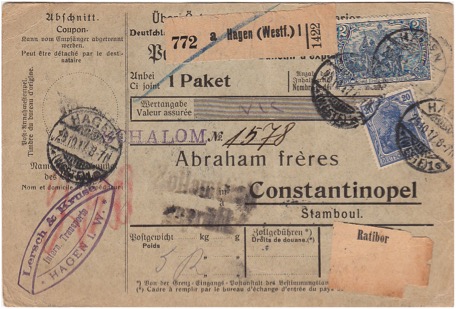
Parcel Card sent from Hagen, Germany, by Lersch & Kruse (transporter), October 25-29 1917.
Another card mailed from Hagen, this one with a "Schalom" stamp.
(Scan courtesy of Mehmet Sadettin Fidan)
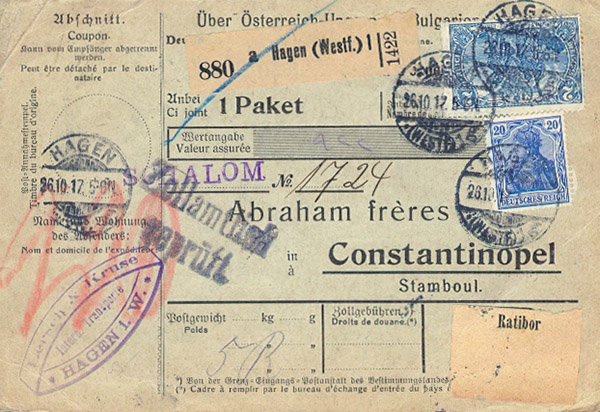
Parcel Card sent from Hagen, Germany, by Lersch & Kruse (transporter), October 26 1917.
Another card mailed from Hagen with a "Schalom" stamp.
(Collection of the author)
World War I
During the second half of the war, in 1916 and 1917, Haim temporarily moved to Germany, from where he conducted business with local suppliers. He was first in Elberfeld (where Paulmann & Kellermann was located), then in Hagen, Westphalia (where Lersch & Kruse and H Münzing Spedition were located). While Haim was in Germany, his brother Moritz remained in Constantinople from where he ran the company.
Several package cards bear Haim's name as the sender and show that he also travelled to Vienna.
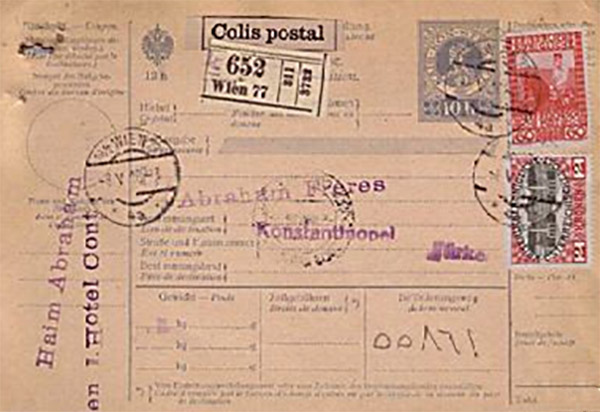
Parcel Card sent by Haim from Vienna, 8 (or 3?) May 1916.
Hotel Continental, Vienna
(Scan courtesy of Mehmet Sadettin Fidan)
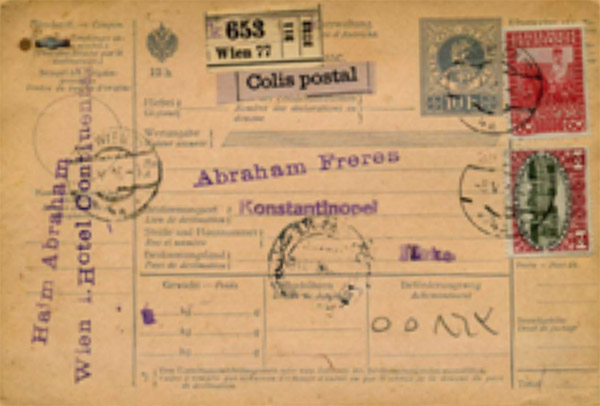
Parcel Card sent by Haim from Vienna, 8 (or 3?) May 1916.
Hotel Continental, Vienna
(Scan courtesy of Mehmet Sadettin Fidan)

Parcel Card sent by Haim from Vienna, 8 May 1916.
Hotel Continental, Vienna
(Scan courtesy of Mehmet Sadettin Fidan)
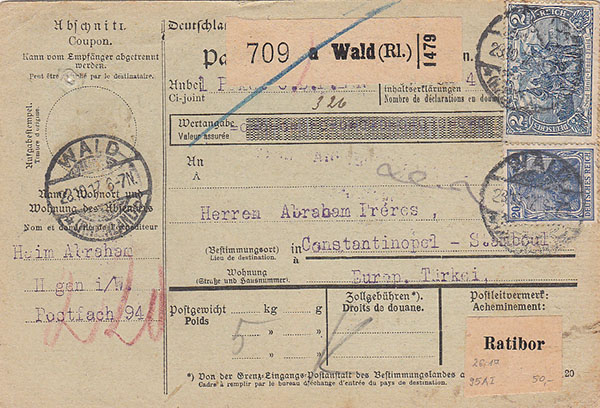
Parcel Card sent by Haim Abraham from Wald, to Abraham Frères, December (?) 1917. At the time, Haim lived in Hagen, Westphalia.
(Scan courtesy of Mehmet Sadettin Fidan)
In addition to these package cards, the other surviving postal artifacts from the war period consist of envelopes sent by Abraham Frères to Germany and The Netherlands with red seals from the Turkish military censorship.
Aktiengesellschaft Union, Augsburg
Presumably "Aktiengesellschaft Union Vereinigte Zündholz- & Wichsefabriken", a match & shoe polish factory.
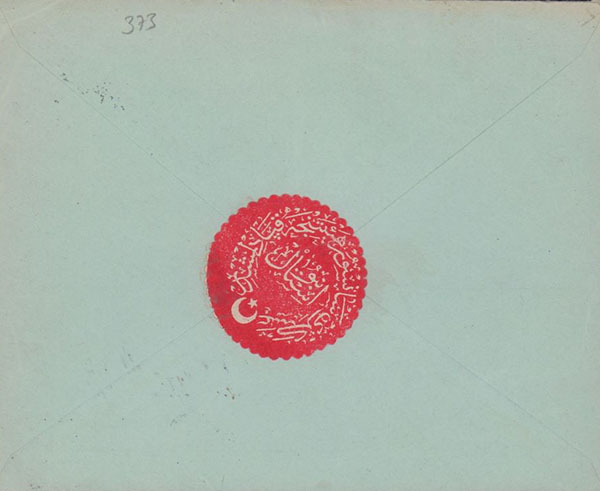
Abraham Frères envelope, from Constantinople to Augsburg, Germany, ca 1916-1917.
(Source: gittigidiyor.com)
Paul Arzberger, Chemnitz, 1916.
Possibly a manufacturer of woven and knitted fabrics, scouring cloths, wicks, cords, gold and embroidery threads.
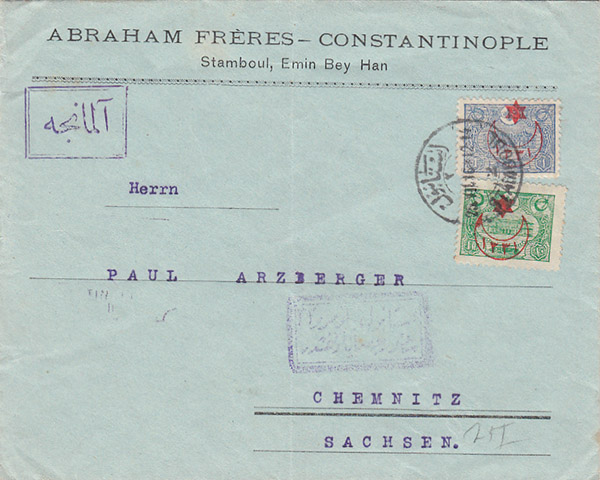
Abraham Frères envelope, from Constantinople to Paul Arzberger, Chemnitz, 1916.
(Scan courtesy of Mehmet Sadettin Fidan)
J.A. Snoeyenbos, Enschede, Holland, July 1916.
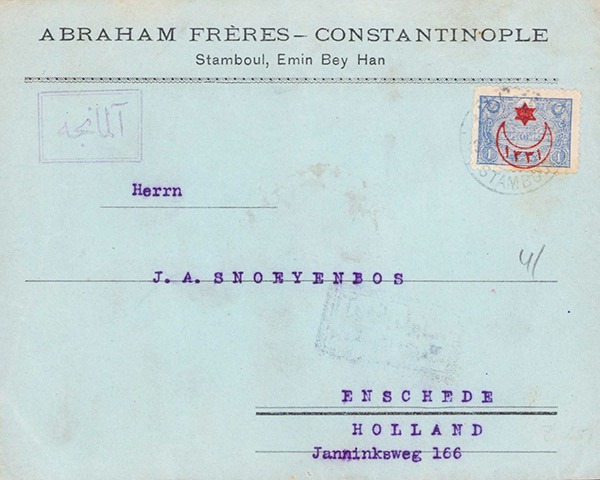
Abraham Frères envelope, from Constantinople to J.A. Snoeyenbos, Enschede.
(Source: phebusmuzayede.com)
The end of Abraham Frères
Although the last surviving artifacts from the company (mail and business card) date from 1918, Abraham Frères continued to operate for a few more years and the company's name still appears in the 1921 Annuaire Oriental.
At the end of 1922, Moritz and Haim had an acrimonious falling out as described in a letter from Elfriede (Mädi) to Ronya dated December 8, 1922, and the company was later dissolved.
This split coincided with Moritz' move to Dusseldorf (actually his move was delayed by a few weeks while he was attempting to resolve the dispute with his brother); It's not clear what triggered the dispute.
Moritz continued to run his business out of the same building for several years, now renting a single room (No 23). He was listed in the 1923 Register of Bankers, Traders and Brokers: Abraham M. Istanbul, Emin Bey Han, 23. Komisyoncu ("commissionnaire", "broker"). His name also appears at the same address in the 1927 Registry Book of the Spanish Consulate in Constantinople, and in the List of Professional Tenants in Emin Bey Han .as "Abraham M."
Haim moved his business to a new location; in the Registry Book of the Spanish Consulate in Constantinople, an entry dated September 18 1928 shows his business address as Seyh Davud Han, Tahtakale street.
Other Abraham Frères
A company with a similar name—this one called "Frères A. & H. Abraham"— operated in Sofia and Rouschouk in the 1920s, as evidenced by this 1924 envlope.
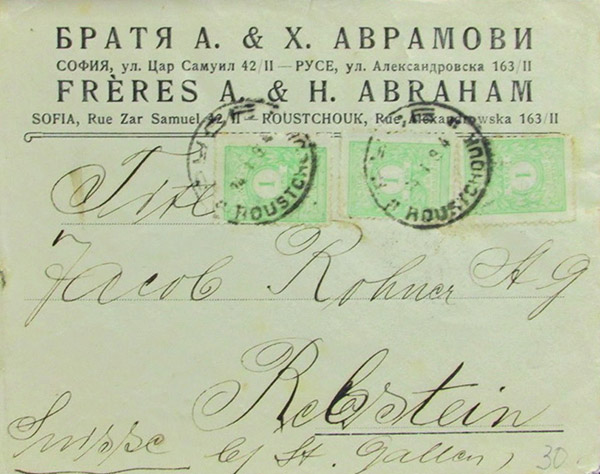
Abraham A. & H. Frères, Roustchouk and Sofia, 1924.
Courtesy of Ron Laby
While "H. Abraham" could plausibly refer to Haim Abraham, the abbreviation "A. Abraham" does not correspond to the name of any of his brothers. This suggests that this company was unrelated to theirs, despite the similar name. (The Bulgarian translation of the company name, АБРАМОВИ, corresponds to "Abramovi," the plural or family form of "Abramov.")
However, considering that the Jewish community of Rustchuk numbered only around 4,000 at the time, it is quite possible that these were relatives—perhaps cousins.
- Special thanks:
- Ron Laby, who generously shared copies of several documents related to the Abraham brothers from his collection of Sephardic-Mizrahi Postal History & Ephemera, and provided background information on package receipt cards.
- Mehmet Sadettin Fidan, who graciously shared his knowledge of Constantinople's Hans, provided a wealth of documents and data about Abraham Frères, including many of the scans of parcel cards presented on this page. (dead link)
- Robert Schild, who provided additional information about Emin Bey Han and shared his deep knowledge of the role of the commissionnaires in Istanbul.
- Cenker Sarıkaya, for his invaluable help and for uncovering artifacts related to the Abraham brothers in Istanbul, including the 1920 issue of La Rassegna Italiana. (2025)
- Sources and References
- Emin Bey Han (dead link)
- 1923 Register of Bankers, Traders and Brokers (dead link)
- archives.saltresearch.org (Annuaire Oriental, 1921)

